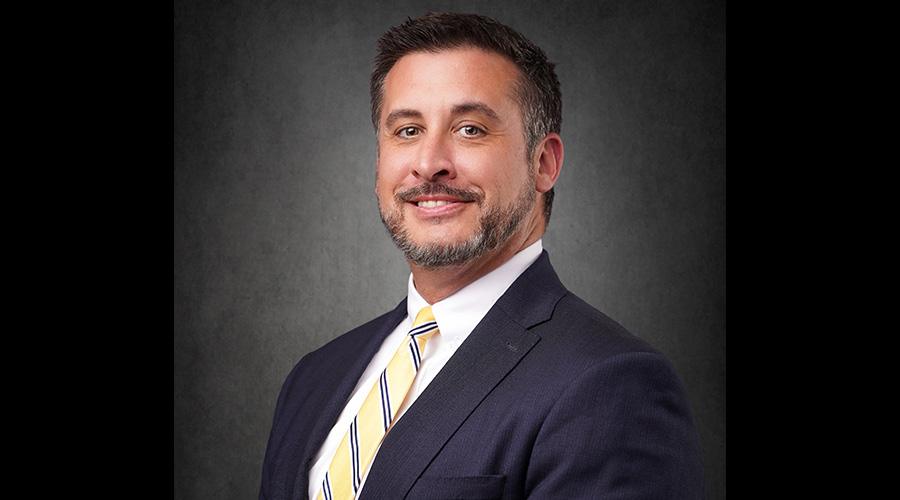Penn State's Green Coach
The university has a bottom-up and top-down environmental strategy. Ford Stryker, deputy associate vice president of facilities, keeps the team on track
For what amounts to one week a month, every month, Ford Stryker is busy building a sustainable university from the ground up. Even with a greenfield site, that’s not easy. Getting it done at the 150-year-old, 1,600-building Pennsylvania State University system is the daunting task that Stryker, deputy associate vice president for the office of physical plant, has been tapped to lead.
Not that Stryker is alone. Penn State is moving forward toward a sustainable future with a cadre of directors and managers that cuts across university functions, as well as with students and faculty. The university’s plan is to show that persistence and patience pay. Penn State is proving it’s better to build alliances than to move forward alone. And it’s showing that if individuals are given the chance to make things better, they will.
This is a new journey for Stryker and Penn State. So even though ground work for its environmental mission was being laid as far back as 10 years ago and the school has taken significant steps toward sustainability, Penn State cannot lay any claim to being the greenest university. Nor can it say that it is even the most energy efficient. But it wants to be both.
Top Down, Bottom Up
Across the University Park campus of Penn State in late winter, there are just small signs of the sustainable future laid out by the Green Destiny Council, an ad-hoc group of staff, faculty and students that was pivotal in getting Penn State rolling toward sustainability. Visible here and there are recycling bins and low-flow showerheads — pieces of the puzzle to be sure but not the indications of a national leader. There is construction on two new green buildings, but even this is a seemingly unambitious beginning for Penn State’s mission to help solve local and global environmental problems. Penn State is inching its way to sustainability.
Change is happening, but school officials are taking the long road, paying as they go, building momentum and incorporating all the members of the school. The pace might be too slow for some, but everyone involved in the process realizes there are hurdles and challenges. Rushing headlong might kill momentum rather than build it.
“We need to be realistic in our expectations but keep trying to make progress, a little bit at a time,” Stryker says. “That’s the only way anything really happens.” Stryker, seemingly motivated by equal doses of pragmatism and optimism, recognizes the broad approach the school is taking requires a little coaxing to keep its momentum. He likens the effort to pushing a bowling ball in the sand. “If you stop pushing, it stops.”
This need for continual support is understood and accepted at the highest levels of the university.
“We try to provide the time and resources to help make it work,” says Graham Spanier, president of Penn State. “But the way we handle the specific issues, that comes from the people. We give them the mandate to do it. I don’t think we have said no to anything that was showing promise.”
Joshua Pearce, who does renewable energy research at the university, is a member of the Green Destiny Council. He says Penn State has made tremendous strides towards sustainability in the last few years. Pearce says university leaders fuel the momentum that began with students and some faculty members. And now top school officials see Penn State as taking a leadership role in a national movement toward environmental stewardship by schools.
The effort to get top university administrators, as well as the Board of Trustees, to buy in to sustainability strategies was aided by the early support of Spanier.
As head of the university, Spanier speaks quite animatedly about Penn State’s environmental mission and is excited about tackling the challenges it presents. But he is realistic.
“We’re not trying to change the world here, just our part of it,” he says. “But we do want to take a leadership role in this effort nationally and globally.”
Environmental Groundwork
Around 1998, the university faced a number of challenges that pressed the need for greater environmental awareness, not the least of which were oil spills on campus and less than approving glances from the state’s Department of Environmental Protection. Then while the administration was revisiting its five-year strategic plan, the Green Destiny Council came out with two reports detailing Penn State’s environmental footprint. What the reports showed was the university had a larger footprint than was necessary.
This confluence of events was a wake up call to school officials and culminated in two significant outcomes. The first was the faculty senate approving a set of goals that became the ecological mission of the university. Then the Office of Physical Plant released its environmental stewardship goals.
“Once the university adopted the ecological mission, I wasn’t sure what, if anything, would happen,” says Chris Uhl, a professor of biology at Penn State and an early advocate of the university’s sustainability mission. “Then president told Ford Stryker to develop an environmental stewardship plan. This was the take-off point.”
Gary Schultz, vice president of finance and business, delivered Spanier’s mandate to Stryker. Schultz says the university was already moving forward on a number of environmental initiatives but they weren’t well recognized.
“We had a lot of things happening,” he says. “A lot of work was already meeting the environmental goals that were only then being talked about, but they were individual efforts and everything was quite diffuse. Pulling them together (into the stewardship goals) wasn’t enough; the effort needed a high level of leadership as well. We identified Ford (Stryker) as a leader on this.”
From both the academic and administrative sides, the Penn State community points to the participation of the Office of the Physical Plant in general and Stryker in particular in the school’s sustainability mission. In fact, Spanier, the president of the university, credits Stryker, who is also manager of the university’s Environmental Stewardship Strategy, as a being pivotal. “Ford has a great deal of interest and knowledge in the environment, but he also knows facilities and is responsible for a budget,” Spanier says.
Stryker and others are banking on the success of the environmental stewardship plan in its careful progression of activities — setting goals, implementing programs and documenting outcomes on a project-by-project basis. It’s the environmental groundwork necessary to achieve the broader goals, Stryker says. The only way to get new projects and new ideas on the agenda is to show results of the previous ones.
The environmental stewardship strategy that guides the efforts is made up of eight goals or strategies: leadership; environmentally responsible purchasing policies; efficient use and conservation of energy, water, and other resources; solid waste minimization; hazardous waste and toxic materials minimization; environmentally responsible campus design and planning; environmentally responsible transportation; and regulatory compliance.
The Real Work of Sustainability
The members of the team responsible for pushing the environmental stewardship goals head up each of these areas. Stryker leads this team and meets with the whole group quarterly but with individual members every week. Constant communication of successes and failures is not only important to solving problems, but it helps keep the environmental mission on the front burner.
The team is credited with doing the real work of sustainability — the projects that show results and that can provide documented improvements in comfort, energy use, material costs or aesthetics on campus.
“We document each little effort so we can continue to build a track record,” Stryker says. “That makes the next, maybe bigger, project that much easier to get approved.”
In the early going, a lot of what the school is accomplishing isn’t flashy. Some successes do get the attention of the campus population because it involves them directly, such as reducing paper use, switching to recycled paper, recycling materials, composting organic matter and implementing integrated pest management procedures. But it’s also repairing steam traps, improving heating systems, upgrading controls and commissioning existing buildings — all to save energy, a strategy that sits at the heart of the campus’ efforts toward sustainability but doesn’t often have a direct impact on the people.
In fact, reducing the campus use of energy may be the most important aspect in these early stages of the school’s environmental efforts. The university’s contribution of atmospheric carbon dioxide, a source of global warming and pollution, is significant because of its reliance on coal-powered electric generation and heat. The reduction of carbon dioxide became a key goal in Uhl’s and his students’ environmental audits. The energy inefficiency of just one building, the Mueller Biology building — the focus of an extensive series of reports — became emblematic of the campus as a whole. The university took these audits to heart.
Stryker’s awareness of energy and other environmental issues wasn’t created at Penn State. He gained it as a facilities and environmental manager with the Navy.
But that wasn’t immediately obvious to researcher and Green Destiny Council member Pearce. Since their first meeting years ago, Pearce says, Stryker’s grasp of the big and little environmental pictures has come to amaze him and is helpful in accomplishing the school’s goals.
“The list of programs he has overseen to benefit the environmental footprint of the university has grown so long I have not been able to keep track,” he says. “In one of the last meetings he suggested that we do a bio-diversity audit. I think I was actually speechless.”
Energy efficiency has become a core objective and drives a lot of the school’s environmental goals. And one of the most cost-effective measures Stryker has been taking is commissioning buildings. He says he can’t imagine operating a building without having all the systems tested and tuned up under real conditions. Commissioning has saved the university significant amounts of energy.
The school is also involved in energy upgrades. The program, called Guaranteed Energy Savings Program (GESP) is initially targeting 10 of 33 buildings studied. The school self-finances the energy upgrades but hires an energy savings company or ESCO to manage the retrofit. As a result, the university gets to keep the savings from day one.
A key to making the GESP work was for the state to allow the university to enter into multiyear contracts — something it can do because it is not tied directly to state government policies that require contracts be bid on an annual basis. The GESP, Stryker says, allows Penn State to plan and work ahead on projects and provide continuity in management and engineering of the jobs.
As important as this work is, it is not obvious to outsiders walking across the campus. There are more apparent steps being taken. The school is building two green, LEED (Leadership in Energy and Environmental Design) certified buildings. LEED, a product of the U.S. Green Building Council, is the only nationally recognized green building rating system.
“LEED is a process that we are going to use for more, possibly all, buildings on campus,” Stryker says.
Like everything else, the LEED buildings will come slowly for awhile.
“We’re not sure where we’re going with this,” Schultz says. “It’s too new. We know that building the cheapest building doesn’t make sense. We are looking at life-cycle costs now.”
Stryker says there is some concern on campus that green buildings won’t be attractive or won’t meet the needs of the user. But once members of the university can see green buildings on campus he expects momentum for them to pick up.
It’s not exactly accurate to say all this is being done on a shoestring budget, but it’s close. The facility department at Penn State is fortunate enough to keep energy savings for reinvestment in other facility projects. It’s a pay-as-you-go program that meets the needs of the facility department as well as school’s business manager.
“We try to do what we can within our financial framework,” Schultz says. What that means is every project has to show a payback of 10 years or less.
Financially Sustainable
For instance, commissioning costs were about $742,000, as of March 2003. That’s for about two and a half years. Annual energy cost savings from that investment has been $196,000. That’s a 3.8-year payback. As a result, Penn State continues to invest in commissioning projects.
At this point, payback numbers aren’t available for the LEED buildings, but that doesn’t bother the school’s chief accountant. “We expect that we will pay some up-front premium for a LEED certification but receive a payback in reduced operating cost,” Schultz says.
Stryker says he expects at most a 5 percent premium with a 4.5- to 6.5-year payback on the energy savings alone.
The one area in the school’s sustainability mission where the payback policy was suspended was in the purchase of wind power for the campus. The school has contracted to buy 5 percent of its power from wind generation. The cost premium is $0.014 per kilowatt-hour at an annual cost of $259,000. Stryker, a firm believer in global warming models endorsed by the majority of leading scientists, was a strong advocate of this. And Schultz agreed and noted that the contract was also based on pragmatism.
“We feel this is the right thing to do,” Schultz says. He says, Penn State should take a leadership role in stimulating wind power generation because it ultimately will mean a less expensive power source for the school.
“This whole process is a journey for us, and we’re building energy, momentum, around it,” Stryker says.
That’s no small task given where Penn State may be headed. The university not only wants to reduce energy use but also eliminate fossil-fuel-based energy sources to eliminate carbon dioxide emissions. It has commissioned a study of what it would take to meet the Kyoto Protocol — an emissions rate of 7 percent less than it was in 1990. Stryker says that’s not possible at this point but it will be interesting trying.
Penn State also wants to reign in water use, reduce the environmental impact of transportation and provide sustainably grown food to the students. It wants to be a zero-waste university. It is, in short, attempting to significantly reduce its environmental footprint.
Penn State is far from achieving all those lofty goals and that sometimes causes frustration on the part of Pearce and other student and faculty members the council. “We are only scratching the surface,” Pearce says. “We are doing a lot of small things that are measurably better for the environment, but we need to start attacking the massive problems such as expanding the GESP from 10 buildings to the entire campus. The political atmosphere here tends to retard any significant changes. Even the most simple improvements can take a long time to implement.” Pearce wants to see a department of energy conservation created within the Office of the Physical Plant and wants all new buildings to be certified Platinum, the highest LEED rating.
A Lot to Deal With
Stryker understands. But he’s also cognizant of what it takes to turn this battleship of a university around — 1,600 buildings is a lot to deal with.
“Joshua (Pearce) would like to see the stewardship strategy move faster and so would I,” he says. “Sometimes, though, things aren’t as simple as they seem. It took us two years to get our guaranteed energy savings program going, and now we have successes and expect to see it accelerate. It takes a lot of planning and preparation. When you are talking about millions of dollars you have to make sure the savings will be real.”
Another challenge is the age of the buildings and systems. Because everything can’t be upgraded at once, inefficient use of energy will be a fact of life. For instance, old HVAC systems that are difficult to balance and buildings with inefficient windows mean that some faculty and staff will have to use electric-resistance space heaters to be comfortable.
“I think generally everyone wants to do the right thing environmentally,” he says. “They want to save energy, they want to build better buildings, but getting there will take time. You have to do it one person, one project, at a time. We have a long way to go.”
Related Topics:











